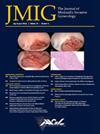Vaginal-Assisted Laparoscopic Sacrocolpopexy (VALS) With Advanced Pelvic Organ Prolapse
IF 3.5
2区 医学
Q1 OBSTETRICS & GYNECOLOGY
引用次数: 0
Abstract
Objective
To review advances of the sacrocolpopexy procedure and demonstrate the Vaginal-Assisted Laparoscopic Sacrocolpopexy approach.
Design
Participants who underwent the Vaginal-Assisted Laparoscopic Sacrocolpopexy approach and consented to intra-operative video documentation were included.
Setting
This research was conducted at a single academic institution.
Interventions
Sacrocolpopexy is an abdominal apical suspension that involves placement of mesh between the vaginal apex and anterior longitudinal ligament overlying the S1-S2 vertebrae. Vaginal Assisted Laparoscopic Sacrocolpopexy (VALS), is a modified approach to sacrocolpopexy. After the hysterectomy, the mesh is attached vaginally to the anterior and posterior vaginal walls. Vaginal dissection of the vesicovaginal and rectovaginal spaces by hand is quick and efficient and allows for palpation of needle depth, which can prevent suture tearing and inadequate mesh attachment with non-tactile placement. The surgeon then transitions back to laparoscopy to complete the remainder of the procedure. Recent literature demonstrates similar rates of mesh complications and reoperation for prolapse with concurrent total hysterectomy versus supracervical hysterectomy given the transition to type I polypropylene mesh and reduction in permanent suture use for vaginal mesh attachment. We anticipate an increase in utilization of the VALS technique given multiple benefits of total hysterectomy, including reduced risk of postoperative menses in premenopausal patients, less postoperative pain and better cosmetic outcomes without need for mini-laparotomy or port-site extension for uterine morcellation, and decreased cervical and endometrial cancer risk. Surgical benefits of the VALS technique include shorter anesthesia and operative time and reduces the need for higher level assistance intraoperatively. VALS is also more ergonomic for the surgeon, promoting use of different muscles throughout the case, thus decreasing muscle fatigue and risk of repetitive motion injury.
Conclusion
Laparoscopic sacrocolpopexy utilizing transvaginal mesh attachment is another tool in the myriad of techniques to treat advanced pelvic organ prolapse. This technique reduces operative and anesthesia time, minimizes mesh complications while maintaining successful outcomes for patients.
Video Abstract
Download: Download video (156MB)
阴道辅助腹腔镜骶尾部成形术(VALS)治疗晚期盆腔器官脱垂。
目的回顾骶骨整形术的进展,展示阴道辅助腹腔镜骶骨整形术(VALS)方法:研究在一家学术机构进行:参与者:接受 VALS 方法并同意术中视频记录的参与者。
本文章由计算机程序翻译,如有差异,请以英文原文为准。
求助全文
约1分钟内获得全文
求助全文
来源期刊
CiteScore
5.00
自引率
7.30%
发文量
272
审稿时长
37 days
期刊介绍:
The Journal of Minimally Invasive Gynecology, formerly titled The Journal of the American Association of Gynecologic Laparoscopists, is an international clinical forum for the exchange and dissemination of ideas, findings and techniques relevant to gynecologic endoscopy and other minimally invasive procedures. The Journal, which presents research, clinical opinions and case reports from the brightest minds in gynecologic surgery, is an authoritative source informing practicing physicians of the latest, cutting-edge developments occurring in this emerging field.

 求助内容:
求助内容: 应助结果提醒方式:
应助结果提醒方式:


